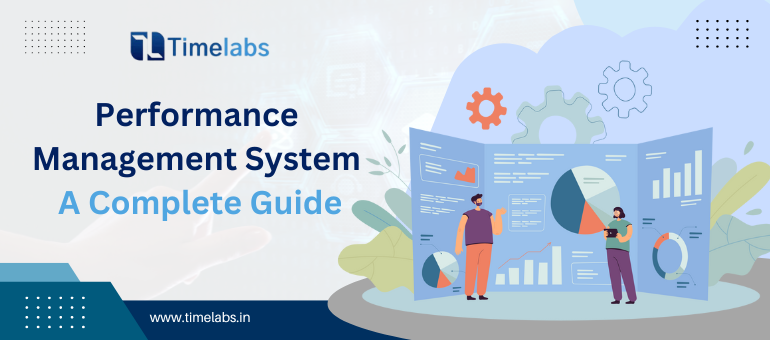Performance management is essential to an organization’s development and success. It entails the ongoing assessment, review, and enhancement of worker performance to bring it into line with the business’s strategic goals and objectives. Organizations use performance management systems to handle performance efficiently. We will examine the definition of a performance management system, as well as its features, advantages, and methods for increasing worker productivity and engagement, in this extensive guide.
What Is Performance Management Software?
An organization can manage employee performance in an organized and methodical way by implementing a performance management system. It entails establishing precise performance standards, offering continuous coaching and feedback, carrying out frequent performance reviews, and coordinating personal aims with company goals. A performance management system’s main objectives are to raise productivity, boost worker performance, and promote overall organizational success.
Over time, performance management systems have seen tremendous evolution. Annual reviews and other traditional performance rating procedures are being replaced by more regular and ongoing feedback channels. The realization that regular coaching and feedback are crucial for staff growth and engagement is what’s causing this change. The main goal of contemporary performance management systems is to foster a culture of constant communication and cooperation between managers and staff.
The Components of a Performance Management System
A performance management system is made up of various essential components that cooperate to guarantee efficient performance management in a company. These elements consist of:
Clearly Defined Performance Standards and Objectives
Elucidating performance objectives and goals for staff members is a basic element of a performance management system. This entails creating SMART (specific, measurable, attainable, relevant, and time-bound) goals that complement the strategic objectives of the company. Employees are better able to focus their efforts on reaching their goals when performance expectations and goals are communicated to them.
Constant Coaching and Feedback
To improve performance and employee development, regular coaching and feedback are essential. A performance management system ought to enable continuous communication between supervisors and staff members, offering chances for regular feedback exchanges. Employees are better able to pinpoint areas for development, close performance gaps, and make the necessary changes to reach their objectives thanks to this ongoing feedback.
Assessment and Evaluation of Performance
An integral part of any performance management system is performance evaluations. These assessments offer a structured method for evaluating worker performance about predetermined objectives and standards. A thorough evaluation of an employee’s performance, strengths, areas for growth, and development needs is included in performance assessments, which can be carried out regularly (e.g., quarterly or annually).
Rewarding and Recognizing Performance
Motivation, engagement, and retention of employees depend heavily on performance recognition and rewards. Employee contributions and accomplishments should be recognized and rewarded through a performance management system. This could take the shape of cash payouts, job advancements, more responsibility, or public acknowledgment.
Employee Development and Training
Investing in the training and development of employees is crucial to enhancing their performance and promoting organizational growth. A system of performance management ought to include tools for determining areas in which employees require improvement, offering chances for skill development, and assisting staff members in advancing their careers.
Must read: The Importance of Attendance Management Systems for Business Success
The Advantages of Putting in Place a Performance Management System
Establishing a performance management system has many advantages for organizations and employees. Among the main advantages are:
Enhanced Worker Productivity and Performance
A well-thought-out performance management system aids staff members in understanding expectations and goals, getting regular coaching and feedback, and coordinating their efforts with the strategic goals of the company. The productivity and performance of employees are enhanced by this clarity and the continuous support that it provides.
Enhanced Employee Engagement and Satisfaction
The implementation of a performance management system that prioritizes continuous communication, coaching, and recognition can cultivate an engaged and contented work environment. Employees are more likely to be engaged, motivated, and dedicated to their work when they feel appreciated, supported, and acknowledged for their contributions.
A Greater Accord with Organizational Objectives
A performance management system makes sure that each employee’s goals and objectives are in line with the organization’s overarching objectives. This alignment fosters a sense of purpose and commitment in workers by illuminating how their efforts impact the organization’s success.
Determining the High Performers and Developing Areas
A performance management system assists in identifying high-performing workers who can be developed for leadership roles or assigned more responsibilities through performance evaluations and assessments. Additionally, it draws attention to areas where workers might benefit from more guidance or training, allowing for focused interventions to improve output.
Assistance with Staff Development and Advancement
Employee professional development is facilitated by a performance management system, which offers continuous coaching, opportunities for growth, and feedback. Employee retention is raised and a competent and motivated workforce is developed as a result of this emphasis on employee development.
How to Choose the Right Performance Management System?
Choosing the right performance management system for your organization is crucial to its successful implementation and adoption. Here are some key factors to consider when selecting a performance management system:
A. Alignment with Organizational Goals and Culture
The performance management system should align with the goals, values, and culture of your organization. It should be flexible enough to accommodate your unique requirements and support your desired performance management processes.
B. User-Friendly and Intuitive Interface
The performance management system should have a user-friendly and intuitive interface that is easy to navigate and use for both managers and employees. It should be accessible from multiple devices, such as desktops, laptops, and mobile devices, to ensure ease of use and convenience.
C. Customization and Scalability
The performance management system should be customizable to meet your specific needs and scalable to accommodate future growth. It should allow you to configure performance evaluation criteria, rating scales, goal-setting processes, and reporting requirements according to your organizational requirements.
D. Integration with Other HR Systems
Consider whether the performance management system can integrate with your existing HR systems, such as payroll, learning management, and talent management systems. Integration ensures seamless data flow and eliminates the need for manual data entry, saving time and reducing errors.
E. Analytics and Reporting Capabilities
The performance management system should provide robust analytics and reporting capabilities to track and analyze performance data. It should offer real-time insights into employee performance, goal progress, and overall organizational performance, enabling data-driven decision-making.
Must read: An in-depth Look at the Three Main Types of HR Software Solutions
Best Practices for Implementing a Performance Management System
Implementing a performance management system requires careful planning, communication, and change management. Here are some best practices to consider:
A. Communicate the Purpose and Benefits
Communicate to employees the purpose and benefits of implementing a performance management system. Explain how it will support their professional growth, enhance their performance, and contribute to the overall success of the organization.
B. Train Managers and Employees
Provide comprehensive training to managers and employees on how to effectively use the performance management system. Train managers on providing feedback, conducting performance evaluations, and setting goals. Educate employees on how to navigate the system, update their goals, and seek feedback.
C. Foster a Culture of Continuous Feedback
Encourage a culture of continuous feedback and open communication within the organization. Emphasize the importance of ongoing conversations between managers and employees to provide feedback, address concerns, and support development.
D. Regularly Review and Update Performance Criteria
Regularly review and update performance criteria, rating scales, and evaluation processes to ensure their relevance and alignment with changing business needs. Seek feedback from employees and managers to identify areas for improvement and incorporate their suggestions.
E. Monitor and Evaluate the System’s Effectiveness
Continuously monitor and evaluate the effectiveness of the performance management system. Collect feedback from employees and managers to identify any challenges or areas that need improvement. Make necessary adjustments to the system to enhance its efficiency and impact.
Overcoming Challenges in Performance Management
Implementing a performance management system can present challenges that organizations need to address. Some common challenges include:
A. Resistance to Change
Resistance to change is a common challenge during the implementation of a performance management system. To overcome resistance, involve employees in the process, communicate the benefits, and provide training and support to help them adapt to the new system.
B. Lack of Managerial Support and Training
Managers play a crucial role in the success of a performance management system. Lack of support and training for managers can hinder effective implementation. Provide comprehensive training and ongoing support to managers to equip them with the necessary skills and knowledge to effectively manage employee performance.
C. Ineffective Goal Setting and Alignment
Setting clear, specific, and achievable goals is essential for effective performance management. Organizations may face challenges in aligning inpidual goals with organizational objectives. Provide guidance and resources to managers and employees to ensure effective goal-setting and alignment.
D. Insufficient Feedback and Communication
Lack of regular, constructive feedback can hinder employee development and engagement. Encourage managers to provide ongoing feedback and facilitate open communication channels to promote a culture of continuous improvement.
E. Inadequate Performance Evaluation Processes
Performance evaluations should be fair, consistent, and based on objective criteria. Ensure that performance evaluation processes are well-defined and transparent, and provide meaningful insights into employee performance. Train managers on conducting effective performance evaluations and addressing performance gaps.
Must read: Techniques for Efficient Remote Payroll Management in India
The Role of Technology in Performance Management
Technology plays a significant role in enhancing the effectiveness and efficiency of performance management systems. Performance management software provides organizations with the tools and capabilities to automate and streamline performance management processes. Key features of performance management software include:
A. Goal Setting and Tracking
Performance management software enables organizations to set and track inpidual and team goals. It provides a centralized platform for employees to document their goals, track progress, and receive feedback and coaching.
B. Ongoing Feedback and Coaching
Performance management software facilitates ongoing feedback and coaching between managers and employees. It provides a platform for managers to provide real-time feedback, recognize achievements, and address performance gaps.
C. Performance Evaluation and Assessment
Performance management software automates the performance evaluation process, making it easier to conduct comprehensive and fair assessments. It provides predefined evaluation criteria, rating scales, and customizable evaluation forms.
D. Analytics and Reporting
Performance management software generates real-time analytics and reports on employee performance, goal progress, and overall organizational performance. It provides insights that help organizations identify trends, strengths, and areas for improvement.
E. Integration with Other HR Systems
Performance management software can integrate with other HR systems, such as payroll, learning management, and talent management systems. Integration ensures seamless data flow and eliminates the need for manual data entry.
Integrating Performance Management with Talent Management
Performance management and talent management are closely interconnected. Integrating performance management with talent management processes can help organizations identify high-potential employees, support their development, and align their skills and capabilities with future organizational needs. Key integration points include:
A. Succession Planning
Performance management data can inform succession planning efforts by identifying high-performing employees who have the potential to assume leadership roles. Organizations can use performance data to create development plans and provide targeted training to groom future leaders.
B. Learning and Development
Performance management data can identify skill gaps and development needs. Integrating performance management with learning and development initiatives enables organizations to provide targeted training and development opportunities to address these gaps.
C. Career Development
Performance management data can inform career development discussions and decisions. Organizations can use performance data to identify employees’ strengths and areas for improvement, align them with career paths, and provide growth opportunities.
D. Compensation and Rewards
Performance management data can inform compensation and reward decisions. Organizations can use performance data to determine performance-based bonuses, salary increases, and recognition programs.
E. Talent Acquisition
Performance management data can provide insights into the effectiveness of talent acquisition strategies. Organizations can analyze performance data to identify recruitment patterns, determine the success of hiring decisions, and make data-driven improvements to the talent acquisition process.
Must read: A Recruitment Management System’s Significance in Organizing a Successful Recruitment Team
Performance Management and Employee Engagement
Performance management and employee engagement are interconnected. A well-designed and effectively implemented performance management system can drive employee engagement by:
A. Clarifying Expectations and Goals
Clear performance expectations and goals help employees understand what is expected of them and how their work contributes to the organization’s success. This clarity fosters a sense of purpose and engagement.
B. Providing Ongoing Feedback and Recognition
Regular feedback and recognition are crucial for employee engagement. A performance management system that emphasizes ongoing communication and recognition helps employees feel valued and appreciated for their contributions.
C. Supporting Career Development and Growth
Performance management systems that incorporate development plans and growth opportunities demonstrate the organization’s commitment to employee growth and career advancement. This support enhances employee engagement and loyalty.
D. Fostering a Culture of Performance Excellence
A performance management system that promotes a culture of performance excellence encourages employees to strive for continuous improvement and excellence. This culture of high performance fosters engagement and a sense of pride in one’s work.
E. Aligning Inpidual and Organizational Goals
Performance management systems that align individual goals with organizational objectives create a sense of shared purpose and engagement. When employees understand how their work contributes to the organization’s success, they feel more engaged and motivated.
Performance Management Trends and Future Outlook
Performance management is continuously evolving to meet the changing needs and expectations of organizations and employees. Some emerging trends in performance management include:
A. Continuous Performance Management
The shift from traditional annual performance reviews to continuous performance management is gaining momentum. Organizations are embracing ongoing feedback, frequent check-ins, and real-time performance tracking to foster continuous improvement and agility.
B. Focus on Employee Development and Growth
Performance management systems are placing greater emphasis on employee development and growth. Organizations are investing in personalized learning and development opportunities to support employee skill enhancement and career advancement.
C. Integration of Performance and Well-being
Organizations are recognizing the importance of employee well-being in driving performance. Performance management systems are incorporating well-being initiatives, such as mental health support, work-life balance, and flexible scheduling, to enhance employee engagement and productivity.
D. Use of Advanced Analytics and AI
The use of advanced analytics and AI is revolutionizing performance management. Organizations are leveraging these technologies to analyze performance data, identify patterns, predict future performance, and provide personalized recommendations for employee development.
E. Shift toward Team-based Performance Management
Performance management is shifting from individual-focused to team-based approaches. Organizations are recognizing the importance of collaborative and cross-functional teamwork in driving performance and are aligning performance management processes to reflect this shift.
Must read: The Definitive Guide for Selecting a Saas-based Cloud Payroll Software
Conclusion
A performance management system is a critical tool for organizations to effectively manage employee performance and drive organizational success. By setting clear performance expectations, providing ongoing feedback and coaching, conducting regular performance evaluations, and aligning individual goals with organizational objectives, performance management systems contribute to improved employee performance, engagement, and productivity. As organizations embrace digital transformation and evolving workforce dynamics, it is essential to choose the right performance management system, integrate it with talent management processes, and adapt to emerging trends to stay competitive and foster a high-performance culture.
In summary, a well-designed and effectively implemented performance management system can unlock the full potential of employees, drive organizational growth, and create a culture of continuous improvement and excellence. With the right tools, processes, and commitment, organizations can achieve their performance management goals and empower their workforce to reach new heights of success.



